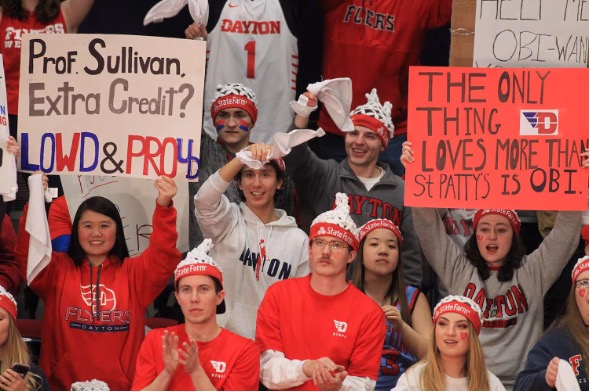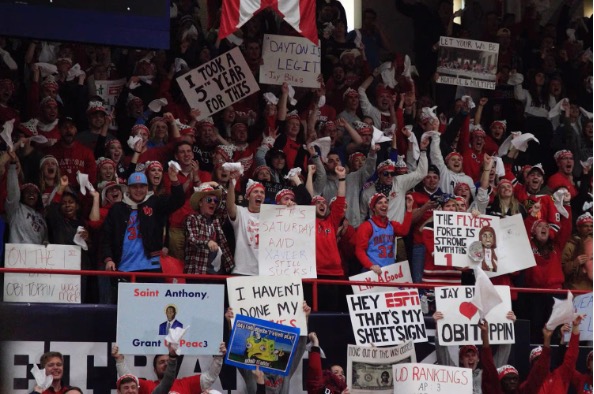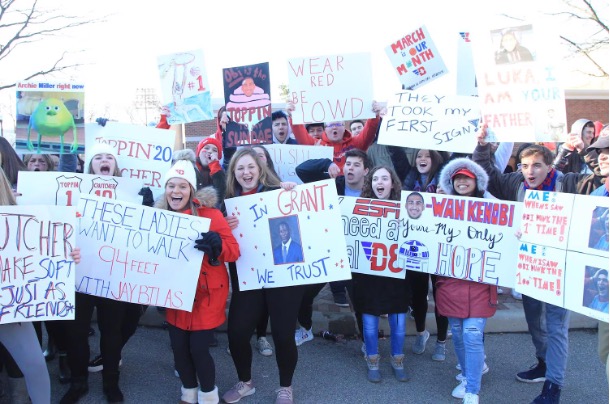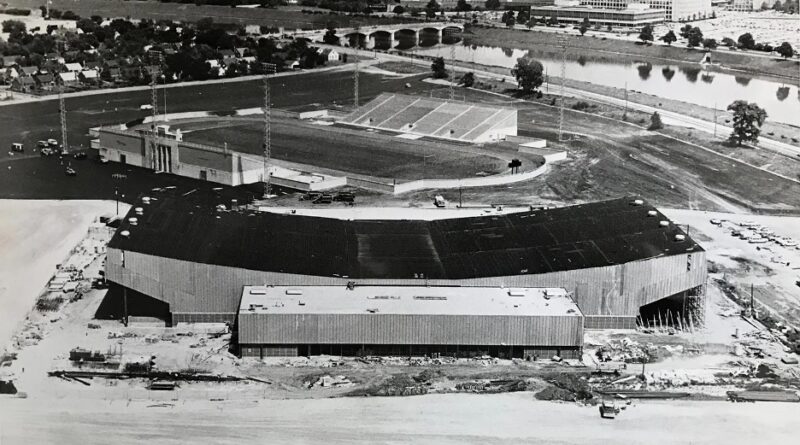Past, Present, and Possibility: Dayton’s Flight Through Basketball History
Austin Callahan | Contributing writer
Before packed crowds and tournament runs, Dayton basketball was already building a name for itself. The program’s foundation was laid nearly 75 years ago, shaped by players, coaches and most of all, the fans.
A city rich with basketball tradition and fans passionate about their team, the Flyers have enjoyed storied success since that became their name in the 1920s.
Dayton’s rise to national prominence began under legendary head coach Tom Blackburn, who became the school’s first full-time coach in 1947. He’s now the namesake of Blackburn Court at UD Arena. Known as a strict disciplinarian, Blackburn recruited former military men and expanded Dayton’s schedule to play regional powerhouses like Louisville. The Flyers reached the NIT championship in 1951 and made their first NCAA Tournament appearance the next year in 1952.
As success grew, so too did the fanbase. The need for a bigger gym became apparent, so the university built the 5,800-seat UD Fieldhouse and opened its doors in 1950. UD Fieldhouse is known today as the Frericks Center, home to Dayton volleyball.

Photos via University of Dayton Archives & r/Elivs Reddit
In the 1950s and early 60s, Dayton reached six NIT finals, won the NIT in 1962, and held the No. 2 AP ranking for much of the 1955-56 season. Blackburn’s success helped build the Flyers’ national reputation.
When Blackburn fell ill to lung cancer during the 1963-64 season, it was assistant coach Don Donoher who stepped in to pick up where Blackburn left off. He led Dayton to two straight Sweet Sixteens and a national title game appearance in 1967, where the Flyers fell to John Wooden’s UCLA.

NCAA championship game in Louisville, Kentucky, March 25, 1967. (AP Photo/Charles Kelly)
With the fanbase still growing, the university thought it wise to once again expand stadiums and thus, ground broke on University of Dayton Arena Nov. 7, 1968. The Flyers would play the first game in their new home the following year and snuck away with a 72–70 win over Bowling Green on Dec. 6, 1969.
Donoher coached for 25 years, finishing 437-225, still the most wins in program history. He was inducted into the College Basketball Hall of Fame in 2015 and passed away on April 12, 2024 at age 92.
After Donoher, the program saw ups and downs under Jim O’Brien, Oliver Purnell and Brian Gregory. But in 2014, Dayton broke through. As a No. 11 seed, the Flyers upset No. 6 seed Ohio State 60-59, then took down No. 3 Syracuse and No. 10 Stanford to reach the Elite Eight where they eventually fell to top-seeded Florida.

Photo via Jared Wickerham—Getty Images & Dayton Daily News Staff
Few people have been closer to the program than David Jablonski, who’s covered Dayton basketball since that Elite Eight run in 2013.
“It was kind of a wild ride,” Jablonski said. “Like a lot of seasons, it had a lot of ups and downs – a lot like this past season [2024–25]. They did so well in non-conference play and struggled in the beginning of conference play.”
“It was the rare season where everyone was happy at the end,” Jablonski said candidly.
The 2019-20 Dayton team also had a season to remember. Led by National Player of the Year Obi Toppin and National Coach of the Year Anthony Grant, the Flyers finished 29–2 and ranked No. 3 nationally.
“Nationally, I think it’s still hard for Dayton to get much attention,” Jablonski said. “They have to go really above and beyond like they did in the 2019–20 season.”
Just as fans were gearing up for a deep tournament run, the COVID-19 pandemic canceled March Madness and thus ended Dayton’s season without a chance, leaving Dayton fans with a hard-to-stomach “what if?” “[The fanbase] tasted what could have been that 2019–20 season and how it ended,” Jablonski said. “And it’s been really hard to recapture that or even come close,” explained Jablonski.



Photos via Dayton Daily News Staff
As college athletics shifts, though, the Flyers don’t have time to dwell on what might have been.
“The next step is capitalizing on this new era of college athletics with schools paying players directly,” Jablonski said.
Dayton is adapting to the NIL (Name, Image and Likeness) era where college athletes can make money from endorsements, get paid for social media posts, earn cash by using their name and other methods.
There are still many unknowns, but programs must learn to support players both on and off the court to stay competitive in a new era of college basketball with an ever-prevalent transfer portal.
“Consistency is the big word,” Jablonski added.
Social media now plays a huge role in player branding and engagement too, something the likes of Tom Blackburn and Don Donoher never had to think about.
“It’s hard to imagine where it was at the start compared to where it is now,” Jablonski said of social media compared to 2013 when he started covering the Flyers.
Dayton has proven it can adapt but the road ahead won’t be easy. With a passionate fanbase and a city that backs its team, the Flyers have the foundation to keep moving toward consistent success. Still, with the pace of change in college basketball, nothing is guaranteed.

